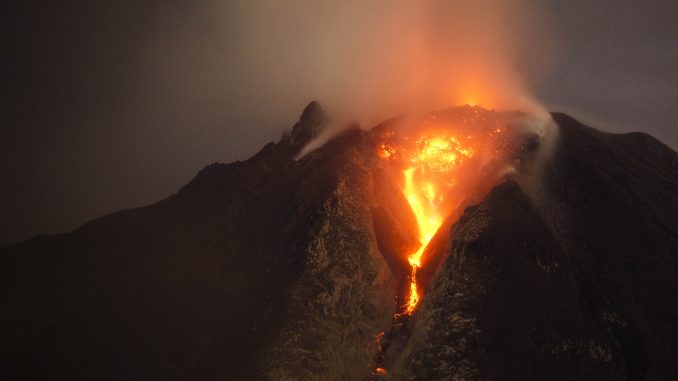
Scientists have warned that extremely high temperature readings emanating from the Gulf of Mexico in the last week might be a precursor to a deep underwater supervolcano eruption.
Scientists working on the RFS Viktor Leonov CCB175 recorded water off the South American nation of Ecuador disappearing on January 5. Three days later, on January 8, waters began disappearing off the North American Florida coastline – which was followed 24 hours later by a huge 7.6 magnitude earthquake in the Caribbean Sea adjacent to the Gulf of Mexico.

BYPASS THE CENSORS
Sign up to get unfiltered news delivered straight to your inbox.
You can unsubscribe any time. By subscribing you agree to our Terms of Use
Latest Video
Whatdoesitmean.com reports: Quickly following these mysterious events in and around the Gulf of Mexico, the Gulf Stream disruption it caused precipitated violent weather to strike the entirety of the European Continent.
Most concerning about these events were the rapidly rising, then rapidly cooling temperatures of the entire Gulf of Mexico—with one location hitting the unprecedented high of over 55 degrees Celsius (+130 degrees Fahrenheit).
With the average sea surface temperature of the Gulf of Mexico never falling below 23 degrees Celsius (73 degrees Fahrenheit) over the winter for the first time on record last year, and whose “Dead Zone” has grown to its largest size in recorded history, scientists aboard the research vessel say that no evidence suggests these events are due to climate change.
Unlike their Western counterparts, these Russian scientists, when confronted by such mysteries, look backward in time to our Earth’s most ancient stories and myths to see if parallels can be drawn to what is happening now—and that led an examination of the Maya peoples who in ancient times inhabited this entire region—even stretching into the American States of Florida and Georgia.
As documented by Carleton College researcher Lyndon DeSalvo in his 2008 research paper titled “Bleeding Earth: Volcanoes as the Prototypical Mountains in Mayan Cosmological Past”, the Mayapeoples stories and legends of their past speak of the entire Gulf of Mexico as being the place where mountains come from—and, also disappear into—and whose only modern-times explanation of is someone describing the activities of a volcanic caldera—that is a large cauldron-like depression that forms following the evacuation of a magma chamber/reservoir in a supervolcano eruption.
Disregarding the Maya peoples ancient legends, stories and myths that the Gulf of Mexico could, indeed, be a massive volcanic caldera, Western scientists have long sought to discover as to how came to it came to be shaped like one—with the latest attempt being made in 2002 when American geologist Michael Stanton published a speculative essay suggesting an impact origin (comet/asteroid) for the Gulf of Mexico—but that all global geologists quickly rejected for its not having any credibility.
Coming closer to the Maya peoples ancient stories, however, was noted American geologist Dr. David Prior—who, while doing research at Louisiana State University (LSU), became the first scientist to document volcanic eruptions were, indeed, occurring in the Gulf of Mexico—and the discovery of which he wrote about in his 1989 scientific research paper titled “Evidence for Sediment Eruption on Deep Sea Floor, Gulf of Mexico”.
Building on Dr. Prior’s scientific proof of volcanic eruptions occurring in the Gulf of Mexico, in 2003, “asphalt volcanos”—which were never heard of before—were found forming in these waters, too—and that led to massive effort, all around the globe, to re-map all the world’s oceans to discovery just how many underwater volcanoes there are—and when completed, in 2014, revealed thousands of underwater mountains and extinct volcanoes that were previously unknown.
This past May (2017), the first in history detailed seafloor map of the Gulf of Mexico was finally released by the Americans—and whose stunning findings revealed its deepwater seafloor was dominated by canyons, ridges, and faults—some of whose fault lines spread to the ancient Jackson, Mississippi, volcano—and with many believing that further discoveries will soon link the entire Southeastern United States to the feared Trans-Mexican Volcanic Belt.
Going by the events occurring in Mexico between the years 1854-1875, when the Gulf of Mexico region was shaken by 8 powerful earthquakes over 7 magnitude, it’s important to note that during this series of earthquakes, they were coincided by the last volcanoes to ever erupt in the Southeastern United States—and that includes the 20 June 1857 volcanic eruption in Georgia, the 2 September 1866 volcanic eruption off the Gulf of Mexico coast of Florida, and the 18 March 1874 volcanic eruption in North Carolina.


